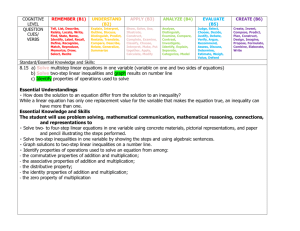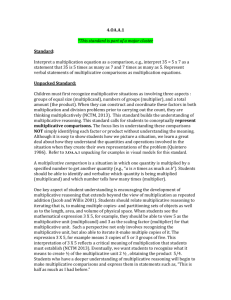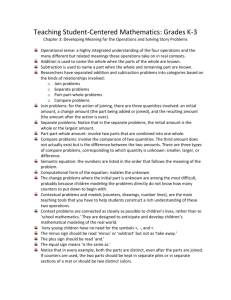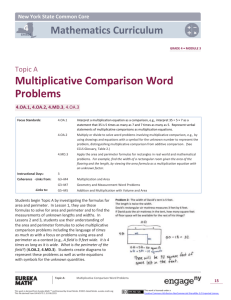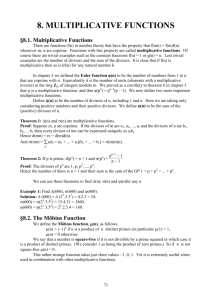3.OA_.A1
advertisement
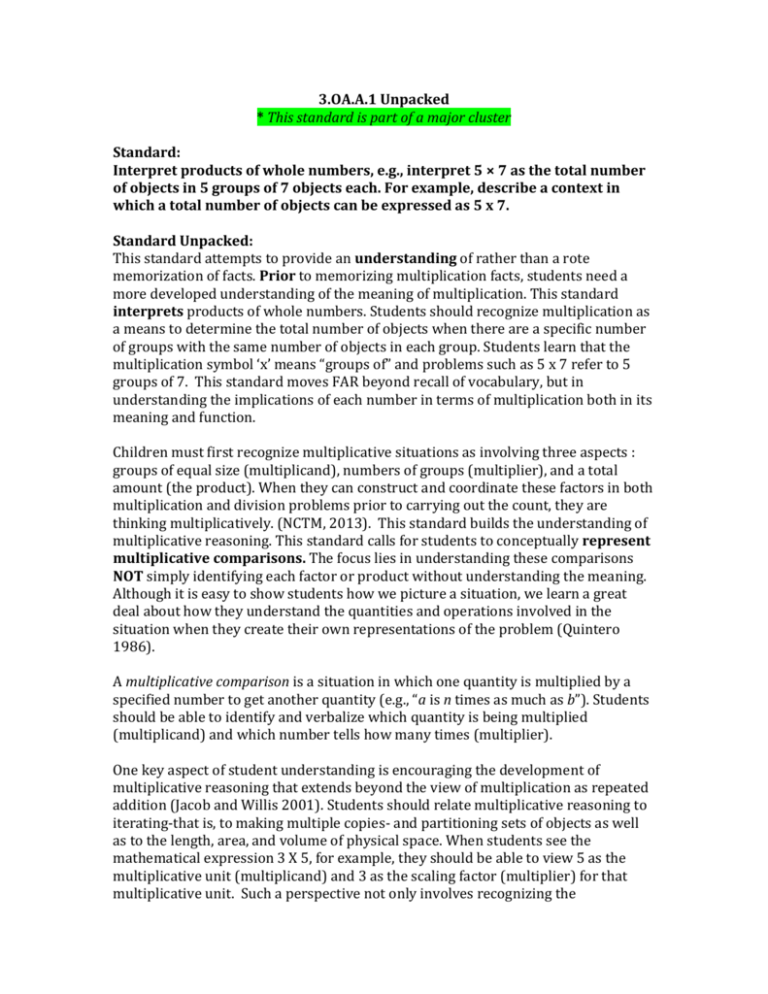
3.OA.A.1 Unpacked * This standard is part of a major cluster Standard: Interpret products of whole numbers, e.g., interpret 5 × 7 as the total number of objects in 5 groups of 7 objects each. For example, describe a context in which a total number of objects can be expressed as 5 x 7. Standard Unpacked: This standard attempts to provide an understanding of rather than a rote memorization of facts. Prior to memorizing multiplication facts, students need a more developed understanding of the meaning of multiplication. This standard interprets products of whole numbers. Students should recognize multiplication as a means to determine the total number of objects when there are a specific number of groups with the same number of objects in each group. Students learn that the multiplication symbol ‘x’ means “groups of” and problems such as 5 x 7 refer to 5 groups of 7. This standard moves FAR beyond recall of vocabulary, but in understanding the implications of each number in terms of multiplication both in its meaning and function. Children must first recognize multiplicative situations as involving three aspects : groups of equal size (multiplicand), numbers of groups (multiplier), and a total amount (the product). When they can construct and coordinate these factors in both multiplication and division problems prior to carrying out the count, they are thinking multiplicatively. (NCTM, 2013). This standard builds the understanding of multiplicative reasoning. This standard calls for students to conceptually represent multiplicative comparisons. The focus lies in understanding these comparisons NOT simply identifying each factor or product without understanding the meaning. Although it is easy to show students how we picture a situation, we learn a great deal about how they understand the quantities and operations involved in the situation when they create their own representations of the problem (Quintero 1986). A multiplicative comparison is a situation in which one quantity is multiplied by a specified number to get another quantity (e.g., “a is n times as much as b”). Students should be able to identify and verbalize which quantity is being multiplied (multiplicand) and which number tells how many times (multiplier). One key aspect of student understanding is encouraging the development of multiplicative reasoning that extends beyond the view of multiplication as repeated addition (Jacob and Willis 2001). Students should relate multiplicative reasoning to iterating-that is, to making multiple copies- and partitioning sets of objects as well as to the length, area, and volume of physical space. When students see the mathematical expression 3 X 5, for example, they should be able to view 5 as the multiplicative unit (multiplicand) and 3 as the scaling factor (multiplier) for that multiplicative unit. Such a perspective not only involves recognizing the multiplicative unit, but also able to iterate it-make multiple copies of it. The expression 3 X 5, for example means 3 copies of 5 or 3 groups of five. This interpretation of 3 X 5 reflects a critical meaning of multiplication that students must establish (NCTM 2013). Eventually, we want students to recognize what it means to create ½ of the multiplicative unit 2 ½ , obtaining the product 5/4. Students who have a deeper understanding of multiplicative reasoning will begin to make multiplicative comparisons and express them in statements such as, “This is half as much as I had before.” Students should be able to have ample opportunities to interpret products by drawing pictures, using repeated addition, using visual arrays, using a number line, skip counting, and using multiplication equations to represent illustrations. Examples: Using arrays: Using Number Lines to Illustrate Skip Counting: Repeated Addition: Grouping: *The intent of the illustrated examples is to provide some visuals for meaning. They by no means are representative of all the various ways for students to model this standard. Questions to check for understanding and increase rigor: Teacher shows an array. Have students list all equations that it represents. (EX. 4 rows, 5 columns: 4x5, 5x4, 20/4, 20/5, 4+4+4+4+4, 5+5+5+5) Create 3 different multiplications arrays that represent 30. Which model for multiplication do you like best? The product is 48. What could the factors be? Model your thinking. Explain the relationship between a factor and product. What happens to the product when one of the factors increases? (for example, when 3x7 becomes 3x8) Distribute 20 color tiles to each pair of students 1. Say aloud a multiplication expression using a variety of wordings. Ex 3 groups of 4; 3 sets of 4; 3 X 4 and 4 + 4 + 4 2. As you say each, allow time for students to build a corresponding model. 3. Ask students if they can label the model in a different way.
